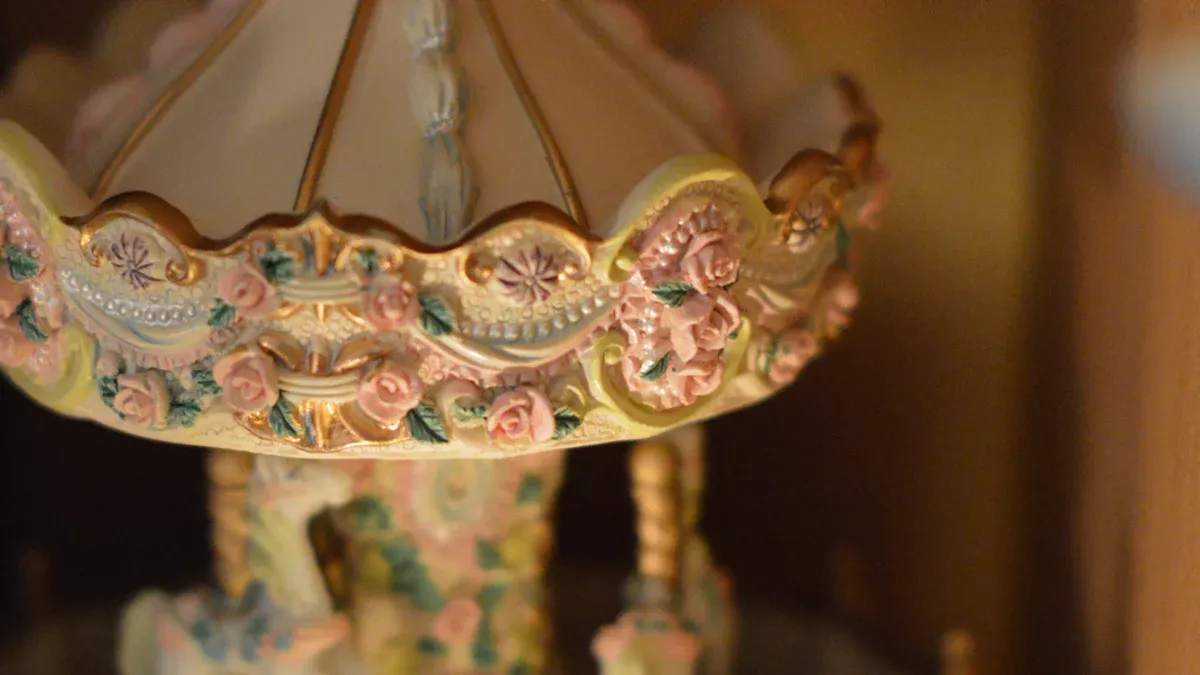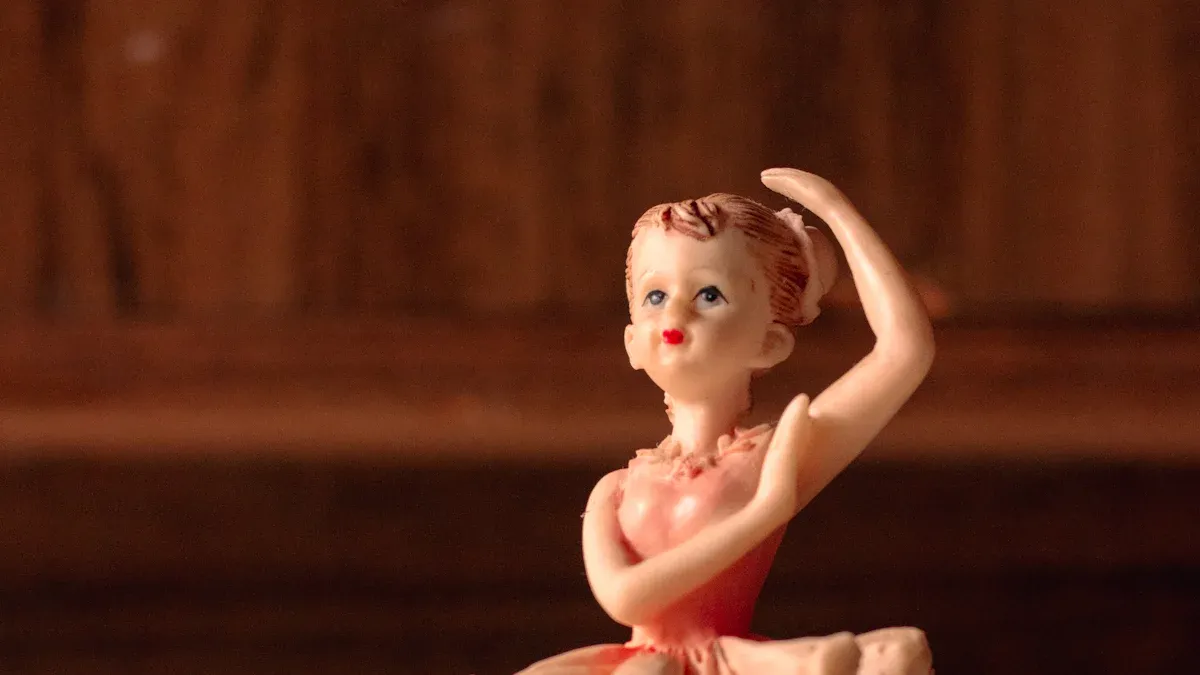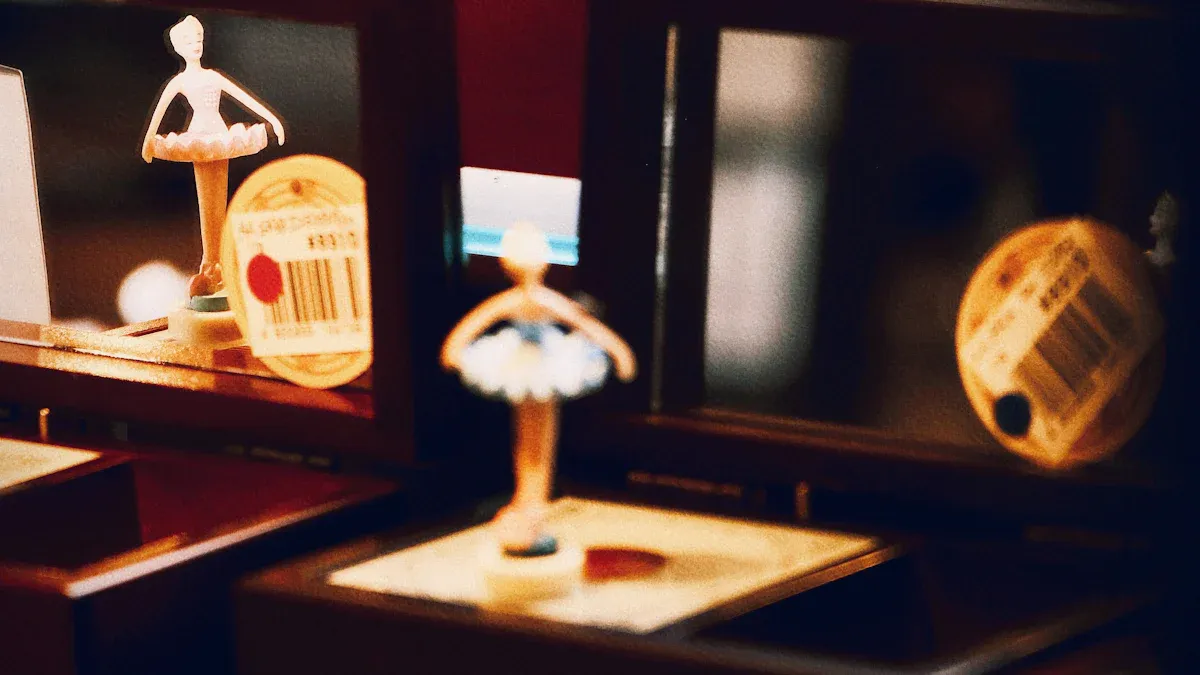
A music box creates melodies as pins on a cylinder or disc pluck metal teeth inside. Collectors admire models such as the Crystal Ball Music Box, Wooden Christmas Music Box, 30 Note Music Box, Jewelry Music Box, and custom 30 note music box.
The global music box market continues to grow:
| Region | Market Size 2024 (USD Million) | Market Size 2033 (USD Million) |
|---|---|---|
| North America | 350 | 510 |
| Europe | 290 | 430 |
| Asia Pacific | 320 | 580 |
| Latin America | 180 | 260 |
| Middle East & Africa | 150 | 260 |
Key Takeaways
- A music box creates melodies by pins on a rotating cylinder plucking metal teeth, with each part like the cylinder, comb, spring, and governor working together to produce clear, steady music.
- The sound quality depends on materials and design choices, such as wood type for resonance and precise tuning of components, which craftsmen refine through careful trial and error.
- Music boxes have a rich history from the 18th century and remain cherished collectibles today, blending engineering and artistry to deliver timeless musical charm.
Music Box Mechanisms and Components

Music Box Cylinder and Pins
The cylinder stands as the heart of a traditional music box. Manufacturers craft it from metal, starting with a flat piece cut to precise size. They drill holes into the metal plate and insert small metal pins, cementing them in place to form the musical cylinder. As the cylinder rotates, these pins pluck the teeth of the metal comb below. Each pin’s position determines which note will play. The cylinder must withstand hundreds of revolutions per minute, so durability and precision are essential. The size and speed of the cylinder influence the tempo and sound of the melody. Ningbo Yunsheng Musical Movement Manufacturing Co., Ltd. uses advanced techniques to ensure each cylinder meets strict quality standards, resulting in clear and consistent musical notes.
Music Box Metal Comb
The metal comb sits beneath the cylinder and contains steel tongues of different lengths. Each tongue, or tooth, produces a unique note when plucked by a pin. Manufacturers use hardened carbon steel for the comb, annealing it for strength and sound quality. Some combs have brass weights attached underneath to fine-tune lower notes, while lead and tin may be soldered on for added mass. The comb attaches to a solid bridge, which transmits vibrations to the wooden soundboard. This process amplifies the sound, making the melody audible and rich. The material and mass of the comb’s base affect how long the notes linger and how pleasing the sound becomes. Brass and zinc alloy bases offer the best balance of resonance and tone.
Tip: The angle and position of the comb relative to the cylinder help balance the volume and improve the performance of the dampers, ensuring every note sounds clear.
Music Box Winding Spring
The winding spring powers the entire music box mechanism. When someone winds the lever, the spring stores elastic potential energy. As the spring unwinds, it releases this energy, driving the cylinder and gear train. The quality and capacity of the spring determine how long the music box will play and how steady the tempo remains. Manufacturers use high-carbon steel or stainless steel for the spring, selecting materials for their strength, elasticity, and resistance to corrosion. Designers must consider factors like coil spacing, direction of wind, and clearance to prevent binding and ensure smooth operation. Proper heat treatment and finishing, such as electroplating, increase the spring’s durability and fatigue life.
| Aspect | Details |
|---|---|
| Typical Materials | Music wire (high-carbon steel), Stainless steel (grades 302, 316) |
| Material Properties | High tensile strength, elasticity, corrosion resistance, fatigue life |
| Design Considerations | Correct torque load, proper preload tension, secure end loops, corrosion resistance |
| Manufacturing Factors | Heat treatment, finishing, production quantity affect quality |
Music Box Governor
The governor controls the speed at which the cylinder rotates, ensuring the melody plays at a steady tempo. The mechanism uses centrifugal force and friction to regulate movement. As the spring unwinds, it turns a worm shaft connected to a rotary member. When the shaft spins quickly, centrifugal force pushes the rotary member outward, causing it to rub against a fixed brake. This friction slows the shaft, keeping the cylinder’s speed constant. Grooves in the rotary member improve sensitivity and consistency. The governor balances centrifugal force and friction to control speed and extend playing time.
| Governor Type | Mechanism Description | Typical Usage Example |
|---|---|---|
| Fan-fly type | Uses rotating fan blades to control speed | Music boxes and barrel-operated instruments |
| Pneumatic type | Regulates speed by controlling suction to an air motor | Piano rolls |
| Electrical fly-ball type | Uses rotating weights to open and close electrical contacts | Mills Violano-Virtuoso |
Music Box Resonance Chamber
The resonance chamber acts as the acoustic stage for the music box. This hollow cavity, usually made from wood or metal, amplifies and enriches the sound produced by the comb. The chamber’s shape, size, and material all influence the final tone and volume. MDF and high-quality plywood work well for enclosures because they minimize unwanted vibrations and enhance sound clarity. Airtight seals and internal insulation, such as foam, prevent sound leakage and absorb unwanted frequencies. Some high-end music boxes use natural wood, like bamboo, shaped into curved cavities for a rich, open sound with strong harmonics. Ningbo Yunsheng Musical Movement Manufacturing Co., Ltd. pays close attention to resonance chamber design, using advanced materials and construction techniques to deliver a full, vibrant musical experience.
Note: The resonance chamber’s design can make a simple melody sound warm and lively, turning a mechanical tune into a memorable musical performance.
How a Music Box Produces Its Unique Sound

Music Box Component Interaction
A music box creates its melody through a precise sequence of mechanical actions. Each component works together to transform stored energy into music. The process unfolds in several steps:
- The user winds the music box by turning the crankshaft.
- The crankshaft rotation sets the pinned cylinder in motion.
- As the cylinder turns, its pins pluck the teeth of the metal comb.
- Each plucked tooth vibrates, producing a musical note. Longer, heavier teeth create lower notes, while shorter, lighter teeth produce higher notes.
- Vibrations travel through the base structure, amplifying the sound.
- The sound waves move into the surrounding air, making the melody audible.
- Spacers in the assembly help preserve vibration and extend the duration of each note.
Note: The careful arrangement of these components ensures that every note rings clear and true, creating the signature sound of a classic music box.
Music Box Tune Creation Process
The creation of a music box tune begins with encoding a melody onto the cylinder or disc. Craftsmen arrange pins around the rotating drum with great precision. Each pin matches a specific note and timing in the melody. As the cylinder rotates, powered by a mechanical crank, the pins pluck the tuned metal teeth of the comb. Each tooth produces a unique note based on its length and tuning. The spring mechanism stores energy and drives the rotation, ensuring the melody plays smoothly.
Modern manufacturing allows for even greater accuracy. For example, 3D printing technology enables the creation of custom cylinders that fit standard mechanisms. This method allows for intricate and accurate encoding of melodies, making it possible to reproduce complex tunes.
The process for arranging and manufacturing music box tunes involves several steps:
- Customers select the number of songs and complete payment.
- After receiving the order, customers submit song information.
- An arranger adapts the melody and rhythm to fit the music box’s technical limits, such as note range, tempo, and polyphony, while preserving the song’s essence.
- A preview audio file is sent to the customer for approval, with up to two minor revisions allowed.
- Once approved, the arranged song is uploaded to the music box before shipment, and the arranger verifies accuracy.
- Customers receive the music box ready to play the chosen tune, along with a MIDI file for future use.
Technical constraints include the note range, maximum simultaneous notes, speed limits, and minimum note duration. Ningbo Yunsheng Musical Movement Manufacturing Co., Ltd. uses advanced techniques to ensure each tune is arranged and manufactured for faithful playback, meeting both technical and artistic standards.
What Makes Each Music Box Distinctive
Every music box has a unique sound, shaped by its materials, craftsmanship, and design philosophy. The choice of wood, such as maple, zebrawood, or acacia, affects resonance and sound clarity. Denser woods enhance sustain and tonal richness. The placement and shape of sound holes, inspired by guitar and violin makers, improve sound projection. Craftsmen may add beams and sound posts to enhance resonance and frequency response.
| Factor | Evidence Summary | Impact on Tonal Quality |
|---|---|---|
| Materials | Maple, zebrawood, acacia; maple for clean sound, zebrawood/acacia for resonance. | Wood type affects resonance, frequency response, and clarity; denser woods enhance sustain and richness. |
| Craftsmanship | Sound hole placement, beams, sound posts, tuning box height and wall thickness. | Proper placement improves projection; beams and posts enhance resonance and frequency response. |
| Design Philosophy | Focus on instrument qualities, not just audio equipment; resonance box design evolved over years. | Unique sound from comb vibration and wooden resonance; design choices optimize tonal uniqueness. |
| Design Iteration | Learning from failed designs, iterative improvements based on feedback. | Refinement leads to better clarity, resonance, and user satisfaction. |
Tip: The design process often involves trial and error. Craftsmen learn from each attempt, refining the music box until it produces the desired sound.
Music Box History and Evolution
The music box traces its roots to the late 18th century. Inspired by large bells and carillons in Europe, Swiss watchmaker Antoine Favre-Salomon invented the first music box in the 1770s. He miniaturized the carillon concept into a small, watch-sized device. Early music boxes used a pinned cylinder to pluck tuned steel comb teeth, producing simple melodies. Over time, music boxes grew larger and more complex, with more teeth allowing for longer and richer tunes.
In 1885, German inventor Paul Lochmann introduced the circular disc music box, which used revolving discs with slots to pluck the comb teeth. This innovation made it easier to change songs. The invention of Thomas Edison’s phonograph in 1877 eventually overshadowed music boxes, offering better sound quality and volume. Despite this, music boxes remained popular as collectibles and sentimental keepsakes.
During the 19th century, Sainte-Croix, Switzerland became a major production center. The transition from cylinder to disc mechanisms allowed for longer and interchangeable tunes, making music boxes more affordable and accessible. The Industrial Revolution enabled mass manufacturing, turning music boxes into popular household items and status symbols. However, the rise of the phonograph and gramophone led to a decline in music box popularity. Economic challenges like World War I and the 1920s crisis further impacted production. Some companies, such as Reuge, survived by focusing on luxury and bespoke music boxes. Today, antique music boxes are highly valued collectibles, and the industry has seen a niche revival centered on craftsmanship and custom creations.
Callout: In the 19th century, music box makers began adding miniature ballerinas to their designs. These figurines, inspired by famous ballets, spun in sync with the music, adding elegance and emotional appeal. Even today, music boxes with ballerinas remain cherished for their classical charm.
A music box combines precise engineering with artistic design. Collectors value these treasures for their melodies, craftsmanship, and history. Notable examples, such as luxury wooden and vintage German silver music boxes, remain highly sought after.
| Category | Price Range (USD) | Appeal/Notes |
|---|---|---|
| Luxury Wooden Music Boxes | $21.38 – $519.00 | Sophisticated design, collectible quality |
| Vintage German Silver Music Boxes | $2,500 – $7,500 | Antiques with historical significance |
The enduring charm of music boxes inspires new generations to appreciate their artistry and legacy.
FAQ
How long does a typical music box play after winding?
A standard music box plays for about 2 to 4 minutes per full wind. Larger models with bigger springs may play for up to 10 minutes.
Can a music box play any song?
Music boxes can play many melodies, but each box has limits. The cylinder or disc must fit the song’s notes and rhythm. Custom tunes require special arrangement.
What is the best way to care for a music box?
Keep the music box dry and dust-free. Store it away from direct sunlight. Use a soft cloth for cleaning. Avoid over-winding the spring.
Tip: Regular gentle use helps keep the mechanism smooth and prevents sticking.
Post time: Jul-10-2025
